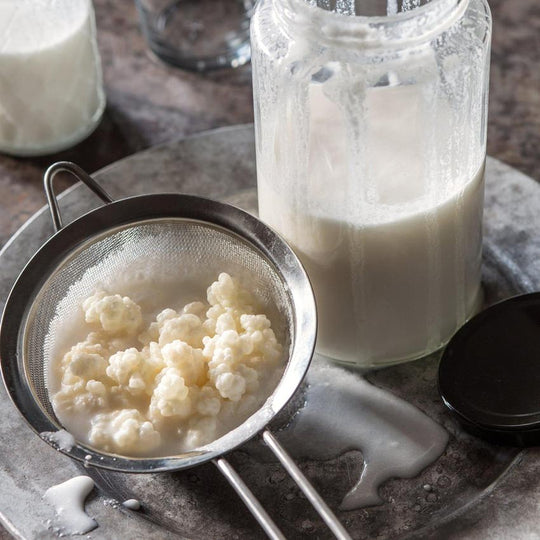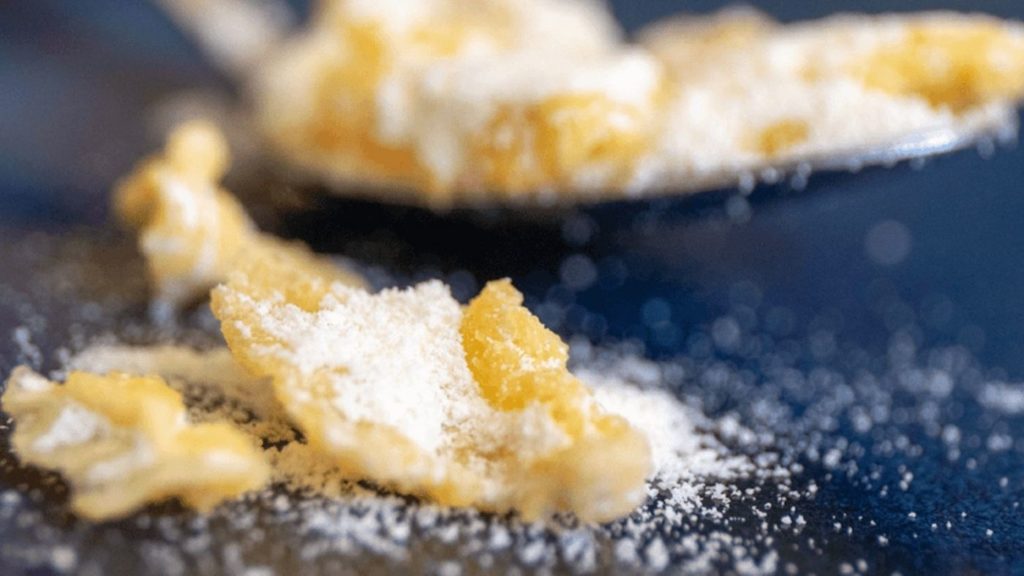Are you the proud owner of milk kefir grains and want to discover how to make milk kefir? This guide provides you with all the steps to follow, as well as lots of practical information. In no time at all, you’ll be mastering this fermented beverage packed with probiotics!
Go straight to the section that interests you:
- What is milk kefir?
- Why make homemade milk kefir?
- Milk kefir recipe
- How to drink your milk kefir?
- How to store kefir grains?
- FAQ
What Is Milk Kefir?
Milk kefir is a creamy, tangy, slightly fizzy fermented beverage that can be made from any animal milk. Its origins can be traced back thousands of years to the heart of the Caucasus mountains.
From the very beginning, milk kefir was renowned for its beneficial properties on health and longevity. Over time, the grains multiplied and travelled through the ages to reach us!
Milk kefir is yogurt’s cousin, but with different microorganisms and in greater numbers. It has a more acidic taste and liquid texture.
Traditionally made from milk kefir grains, it can also be prepared from powdered kefir starters.
Kefir grains are small, white, gelatinous clumps resembling cauliflowers, teeming with a multitude of bacteria and yeast in search of milk to ferment.
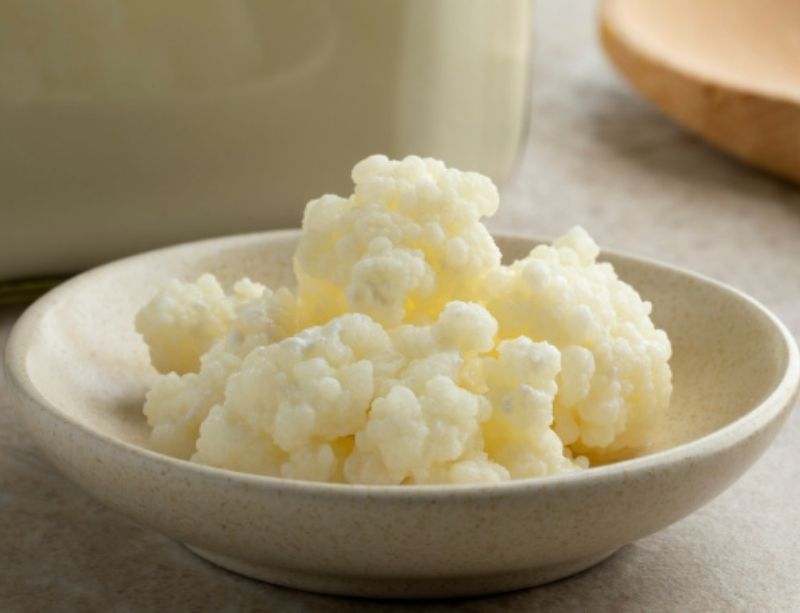
Why Make Homemade Milk Kefir?
There are many advantages to making homemade milk kefir:
- Tasty: Adjust the fermentation time and choose your favorite type of milk to customize acidity, taste, and texture. This way, you create a drink that exactly matches your preferences.
- Quick and easy: With a minimum of equipment and ingredients, you can start a fermentation in minutes, then let nature take care of the rest.
- Risk-free: By following basic preparation and storage instructions, the process is safe, with very little risk of contamination.
- Health benefits: Rich in probiotics, kefir can help boost the immune system, improve digestion, and balance intestinal flora.
Differences Between Homemade and Commercial Milk Kefir
The main advantages of making your own homemade milk kefir, compared to commercial milk kefir, are the following:
- Personalization: Homemade kefir allows you to adjust taste and texture to your preferences, which is impossible with standardized commercial versions.
- Probiotics: Homemade kefir contains an even greater diversity and quantity of active living cultures, beneficial to our health.
- Quality and transparency: Making your kefir guarantees the quality of the ingredients used, with no unknown additives.
- Economy and ecology: It’s more economical and ecological to produce your own kefir, reducing cost and packaging waste.
- Community experience: Home preparation creates a connection with a tradition and a community of fermentation enthusiasts.
However, there are still some drawbacks:
- Time and effort: Preparation requires a commitment in terms of time and regular effort to keep kefir cultures active.
- Consistency: It can be difficult to achieve regular consistency and taste with each recipe, unlike standardized commercial products. Results are less predictable.
- Learning: There is a learning curve to mastering fermentation. This is particularly important when reactivating the grains.
- Access to kefir grains: Finding good quality kefir grains can be challenging depending on the region.
Also, note that commercial milk kefirs generally have a milder taste. Homemade milk kefir presents a more varied and generally funkier range of flavors, due to the wide variety of microorganisms in the grains.
Milk Kefir Health Benefits
Milk kefir is a drink with many virtues, characterized by:
- Its nutritional richness (vitamins B1, B12, folic acid, calcium, and amino acids) (ref.);
- Its high probiotic content (ref.);
- Its anti-inflammatory properties (ref.);
- Its potential beneficial effects on digestion (ref.);
- Skin health (ref.);
- Microbiota well-being (ref.);
- Bone health in certain individuals (ref.).
Milk kefir grains, compared to powdered starter, offer a wider range of benefits due to the diversity and quantity of microorganisms present (including probiotics).
To find out more, see The Benefits of Milk Kefir According to Science.
Equipment Needed to Make Milk Kefir
Homemade milk kefir is easily made with equipment you probably already have at home. You’ll need a:
- Jar
- Breathable cloth, or a non-hermetic lid
- Sieve
It’s also possible to buy an all-in-one kit, such as the Kefirko kit. This kit includes a jar, a sieve, a large mixing spoon, and an adjustable lid.
Kefirko Kefir Making Kit
$47.90 - $54.00
The Kefirko kefir making kit is specially designed to simplify the preparation of milk kefir and water kefir.
Shop nowBefore you start making your kefir, don’t forget to wash all your equipment thoroughly!
Ingredients
Milk kefir requires only two ingredients: milk and milk kefir grains!
Milk
Any animal milk can be used to make milk kefir. Cow’s milk is the most widely used milk for kefir, given its availability and good results.
Goat’s milk makes a tasty kefir, but is slightly more liquid than cow’s milk. If you can get your hands on other animal milk (like sheep, buffalo, camel, mouse), don’t hesitate to experiment!
Lactose-free milk is not an option, because kefir grains feed on the lactose in milk, so if you cut off their food source, they won’t last long.
The higher the fat content of the milk used, the smoother and thicker the kefir will be.
Plant-based milk can technically be used, but is not recommended. Kefir grains are not designed to survive long without animal milk. To experiment without risk, opt for a powdered milk kefir starter, which is affordable and prevents the loss of precious grains.
To find out more, see What is the Best Milk for Making Kefir?
Milk Kefir Grains
Healthy milk kefir grains guarantee vigorous and safe fermentation.
If someone you know makes their own milk kefir, don’t hesitate to ask! As the grains multiply as they ferment, they’re likely to have too many.
Alternatively, you can buy quality milk kefir grains online.
Preparing Milk Kefir in 3 Easy Steps:
- Add the kefir grains to the milk.
- Let them ferment for 24 hours at room temperature.
- Filter and enjoy!
If you’ve just received dehydrated grains, start by reactivating them.
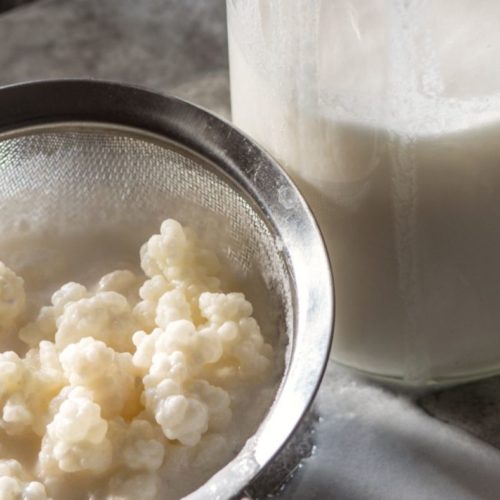
Milk Kefir Recipe
Equipment
- Glass jar
- Sieve or strainer to separate grains
Ingredients
- 2 tablespoons milk kefir grains
- 1 L animal milk
Steps
- Pour the milk into the jar.
- Add the milk kefir grains.
- Stir well.
- Cover the container with a cloth held in place by a rubber band.
- For Kefirko kit users, partially screw upper lid on.
- Let the jar ferment at room temperature for 24 hours (or a maximum of 48 hours). The milk will thicken and develop a tangy taste.
- Filter through the sieve to separate the kefir grains from the liquid.
- And that's it! Your kefir is ready for consumption, and your grains are in prime condition to ferment a new quantity of milk.
Notes
How to Drink Milk Kefir
Plain milk kefir is delicious as is! Its tangy taste, creamy texture, and light fizz make it a refreshing thirst-quencher.
But you can also personalize it! A touch of honey or pureed fruits turns kefir into a creamy smoothie. Or explore savoury options, turning your kefir into a dip, sauce, or fresh cheese. You can even turn it into soda bread!
Here are a few recipe ideas to try with your kefir:
- Milk kefir cheese
- Mascarpone
- Milk kefir tzatziki
- Kefir “Parmesan”
- Crunchy kefir cheese bites
- Kefir cheese appetizer balls
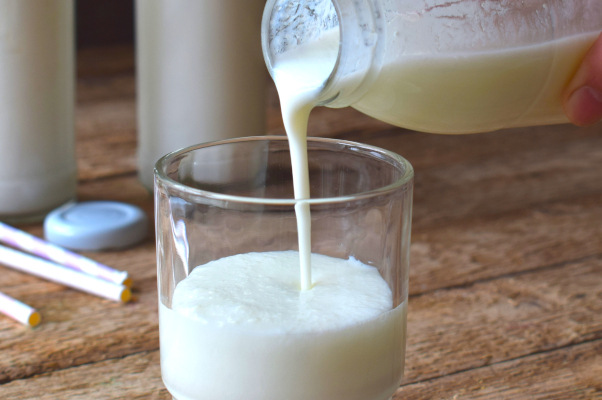
How Do You Know if Your Kefir Is a Success?
A kefir is a success if:
- Its texture has thickened and is smooth.
- It has a tangy taste.
- It has a fresh, slightly acidic smell.
If your kefir meets these conditions, but you find it too runny, you can:
- Let it ferment for longer.
- Use less milk in the next recipe.
- Use milk with a higher fat content.
- Add a little cream at the start of fermentation.
How to Preserve Kefir Grains?
Kefir grains like to be fed regularly. The best way to preserve kefir grains is to… make kefir with them! To avoid ending up with gallons and gallons of kefir, make smaller quantities more often.
There are, however, a few preservation techniques you can use to space out your kefir production.
Short-Term Preservation (1 to 4 weeks)
Place the grains in the fridge in about 2 cups of milk. The grains will continue to transform the milk into kefir, but much more slowly.
Change the milk every week. After the grains have been in the fridge, the first fermentations will take a little longer than usual. But don’t worry: your grains will regain their vigor after just a few batches.
Long-Term Preservation (1 month or more)
Freezing
- Rinse grains in cold water.
- Dry gently on a clean dishcloth, or air-dry.
- Place grains in a freezer bag.
- Add a little powdered milk.
- Put in the freezer.
Dehydration
- Rinse grains thoroughly in cold water and drain well.
- Set the dehydrator to 35°C (95°F) and place the grains in the dehydrator for 24 hours.
- Transfer to a Ziploc bag.
- Add the same weight of milk powder, with 10% baking soda.
- Store in a cool place.
Frequently Asked Questions
My Milk Kefir Is Separating! What Can I Do About It?
If fermentation goes on too long, milk kefir may separate into two layers. The white curdled milk will float to the surface, and the yellowish or translucent whey will remain at the bottom.
If this happens, don’t worry: the taste will simply be a little stronger. Once the grains have been removed, you can always mix the two layers with a whisk or blender.
My Grains Won’t Multiply
Milk kefir grains are known to multiply endlessly. However, they can sometimes be a little reluctant to do so. There are several possible explanations:
- Young grains: if your grains are still young and recently reactivated, be patient. Grains generally start to multiply after a few weeks of regular recipes.
- Frequent pauses: do your grains often go on vacation in your fridge? Frequent pauses destabilize grain health. To ensure their health and reproduction, regular batches are recommended.
Note that if they don’t multiply, it’s not a sign of poor grain health.
Is My Kefir Contaminated?
Thanks to its many beneficial cultures such as lactic acid bacteria and yeast, contamination of kefir is rare. If contaminated, it will show obvious signs: unusual colors or odors, often surface mold. Using fresh milk is crucial because milk close to its best before date is likely to promote the development of bad bacteria.
To Minimize Contamination:
- Always use clean utensils and wash your hands.
- Leave to ferment in a room at a moderate temperature (between 18 and 28°C).
- Keep jars clean (they can be reused for several days before washing).
- Make sure jars are well covered.
With these practices, the risk of contamination remains minimal.
Does your kefir smell of cheese or curdled milk? This can happen and is not always a sign of contamination. Rinse your grains and continue making recipes.
My Kefir Is Slimy/Sticky
Slimy kefir is an undesirable result, but it can happen. Generally, it’s a sign that your grains are under stress. Factors causing this stress can be:
- Changes in fermentation temperature (cold to hot, or vice versa).
- Frequent refrigeration periods.
- Recipes spaced more than 48 hours apart using the same milk.
- Too many or too few grains for the quantity of milk to be fermented.
Rinse your grains briefly with lukewarm water and put them in a new quantity of milk. Let them ferment for 24 hours and rinse again until the consistency is to your liking.
Does Milk Kefir Contain Lactose?
Luckily, kefir contains much less lactose than milk. Some lactose-intolerant people can consume milk kefir without any problem.
Can I Use Plant-Based Milk to Make Kefir?
Yes… and no. If you put kefir grains in soy, coconut, or almond milk, the bacteria and yeast will ferment the liquid.
However, the results may be inconsistent and unsatisfactory. What’s more, kefir grains are not designed to survive for long without animal milk. You can therefore use your extra grains for experimentation, but this is not a long-term solution.
How Do I Recover My Milk Kefir Grains After Fermentation?
To recover your milk kefir grains after fermentation, filter the mixture using an appropriate strainer or sieve. A less efficient method would be to pour the kefir into a shallow bowl and try to catch the grains with a fork.
Make sure you choose a suitable sieve: a model with too large holes risks letting grains through, whereas a very fine sieve could prevent the kefir from passing through. If the kefir is thick, stir it to thin it before filtering.
For an easier method, consider kefir-specific tools, such as the Kefirko kit, which makes it easier to separate kefir and grains without any inconvenience.
What Is the Alcohol Content of Milk Kefir?
Yeast present in grains will produce a small amount of alcohol, comparable to that found in kombucha or water kefir.
In a “young” kefir fermented in 24 hours, you can find around 0.1% alcohol. However, by prolonging fermentation for several days at room temperature, the alcohol content can rise to as much as 2%.
How Can I Get Bubbles in My Milk Kefir?
Plain milk kefir has very few bubbles. You can stimulate fizz production by bottling your kefir in pressure resistant bottles and letting them stand for a few days in the fridge or on the counter.
Be careful not to let the pressure build up too much! You certainly don’t want to clean your ceiling afterwards…
Can I Use Metal With Milk Kefir?
Rumor has it that metal is harmful to kefir grains. It’s a tenacious myth!
You can use any stainless metal without any problem. Most kitchen utensils are made of stainless steel, so they pose no danger to the grains.
What’s the Difference Between Kefir Starter and Kefir Grains?
Kefir grains are the traditional wild culture, while kefir powder starter culture is made from selected kefir bacteria and yeast.
Each option has its strengths and weaknesses, but both can produce high-quality kefir.
On this subject, see also:
What’s the Difference Between Water Kefir and Milk Kefir?
Even though they share the same name, they’re quite different!
Milk kefir grains ferment animal milk to create a tangy yogurt drink.
Water kefir grains ferment sugar water to make a fizzy, slightly vinegary beverage.
To find out more about these two fermentations, see What Are the Differences Between Milk Kefir and Water Kefir?
Get Started!
- Buy milk kefir grains
- Discover the Kefirko Kefir Kit
- All our milk kefir recipes and guides
- How to make cheese from kefir

